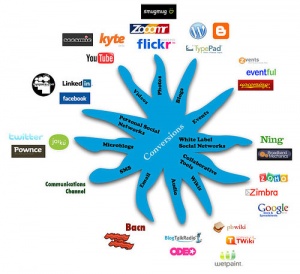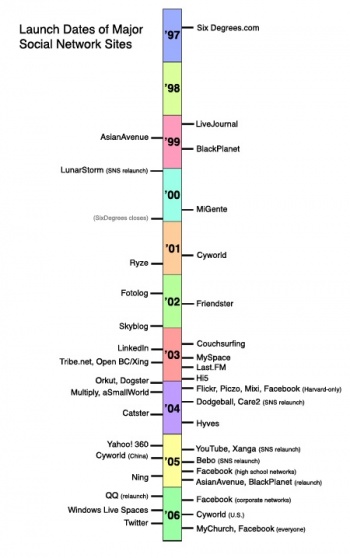Social network service
From Computing and Software Wiki
| Line 8: | Line 8: | ||
The early years, SNSs were in the form of generalized online communities where people interact with each other through chat rooms, and later on, some websites focused on ties with friends by linking people together via email address. The first recognizable social network site "[http://en.wikipedia.org/wiki/SixDegrees.com SixDegrees.com]" launched in 1997, it focused on indirect ties, it combined all the former features with its new features, it allowed people to create profiles, list their friends, surf the friends list, and surf the network that connects people in the same school or with similar interests together. However, while the website attracted lots of users by these new features, it failed to become a profitable business and was shut down in 2000, even the owner believes that it was simply ahead of time.[1] As time goes by, the launching of [http://www.ryze.com/ Ryze.com] helped people leverage their business networks, but it never acquired mass popularity. In 2002, [http://www.friendster.com Friendster] as one of the three most popular SNSs has been launched, unlike the usual online dating sites, Friendster was designed to help friends-of-friends meet, which is based on the assumption that would make better romantic partners than would strangers, but many early users left later on due to technical and social difficulties that the site encountered. Between 2003 to 2007, more and more SNSs emerged, which made the SNS hit the mainstream, such as [http://www.myspace.com/ MySpace], [http://www.bebo.com/ Bebo], and [http://www.facebook.com/ Facebook], they all grew rapidly. MySpace was reportedly getting more page views than Google. In 2006, Facebook opened up to the college communities outside US, plus allowing add-on applications that developed externally, it became the largest and fastest growing site in the world. | The early years, SNSs were in the form of generalized online communities where people interact with each other through chat rooms, and later on, some websites focused on ties with friends by linking people together via email address. The first recognizable social network site "[http://en.wikipedia.org/wiki/SixDegrees.com SixDegrees.com]" launched in 1997, it focused on indirect ties, it combined all the former features with its new features, it allowed people to create profiles, list their friends, surf the friends list, and surf the network that connects people in the same school or with similar interests together. However, while the website attracted lots of users by these new features, it failed to become a profitable business and was shut down in 2000, even the owner believes that it was simply ahead of time.[1] As time goes by, the launching of [http://www.ryze.com/ Ryze.com] helped people leverage their business networks, but it never acquired mass popularity. In 2002, [http://www.friendster.com Friendster] as one of the three most popular SNSs has been launched, unlike the usual online dating sites, Friendster was designed to help friends-of-friends meet, which is based on the assumption that would make better romantic partners than would strangers, but many early users left later on due to technical and social difficulties that the site encountered. Between 2003 to 2007, more and more SNSs emerged, which made the SNS hit the mainstream, such as [http://www.myspace.com/ MySpace], [http://www.bebo.com/ Bebo], and [http://www.facebook.com/ Facebook], they all grew rapidly. MySpace was reportedly getting more page views than Google. In 2006, Facebook opened up to the college communities outside US, plus allowing add-on applications that developed externally, it became the largest and fastest growing site in the world. | ||
| - | == | + | == 222 == |
| - | == | + | == 333 == |
| - | == | + | == 444 == |
| - | == | + | == 555 == |
| - | == | + | == 666 == |
== See also == | == See also == | ||
Revision as of 07:09, 8 April 2009
SNS (Social Network Service) is the application service that helps people builds online social communities where they share interests and/or activities. Most SNSs are web based to provide a variety of ways for users to communicate or interact, such as social network websites, e-mail, SMS (short message service), and blogs.
List of Social networking websites
Contents |
History of SNS
The early years, SNSs were in the form of generalized online communities where people interact with each other through chat rooms, and later on, some websites focused on ties with friends by linking people together via email address. The first recognizable social network site "SixDegrees.com" launched in 1997, it focused on indirect ties, it combined all the former features with its new features, it allowed people to create profiles, list their friends, surf the friends list, and surf the network that connects people in the same school or with similar interests together. However, while the website attracted lots of users by these new features, it failed to become a profitable business and was shut down in 2000, even the owner believes that it was simply ahead of time.[1] As time goes by, the launching of Ryze.com helped people leverage their business networks, but it never acquired mass popularity. In 2002, Friendster as one of the three most popular SNSs has been launched, unlike the usual online dating sites, Friendster was designed to help friends-of-friends meet, which is based on the assumption that would make better romantic partners than would strangers, but many early users left later on due to technical and social difficulties that the site encountered. Between 2003 to 2007, more and more SNSs emerged, which made the SNS hit the mainstream, such as MySpace, Bebo, and Facebook, they all grew rapidly. MySpace was reportedly getting more page views than Google. In 2006, Facebook opened up to the college communities outside US, plus allowing add-on applications that developed externally, it became the largest and fastest growing site in the world.
222
333
444
555
666
See also
References
1. (Boyd & Ellison, 2007, p.3)
2. Wikipedia contributors, "Six degrees of separation," Wikipedia, The Free Encyclopedia, http://en.wikipedia.org/w/index.php?title=Six_degrees_of_separation&oldid=282380925 (accessed April 8, 2009).
External links
--Shensw 23:59, 7 April 2009 (EDT)


